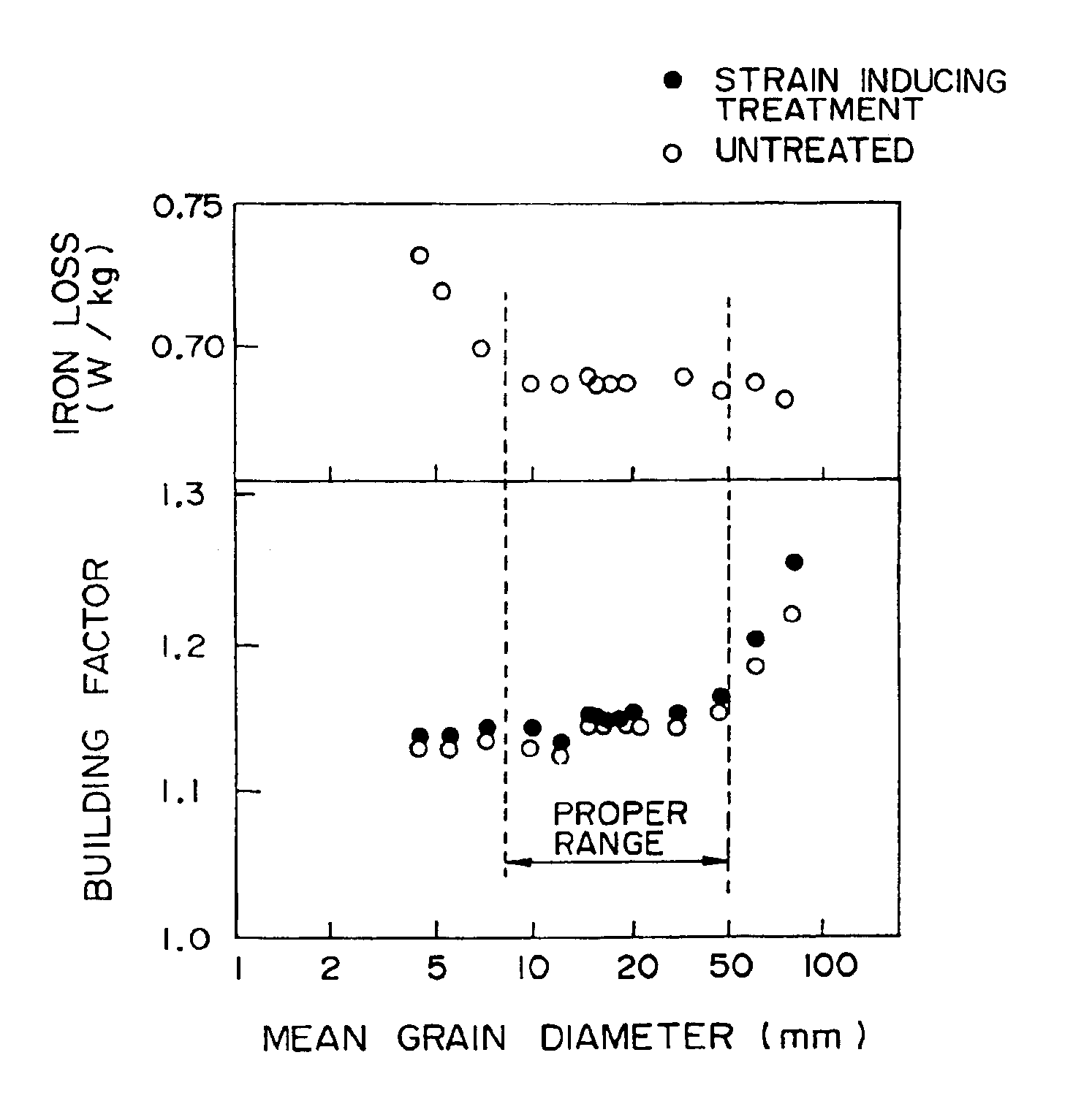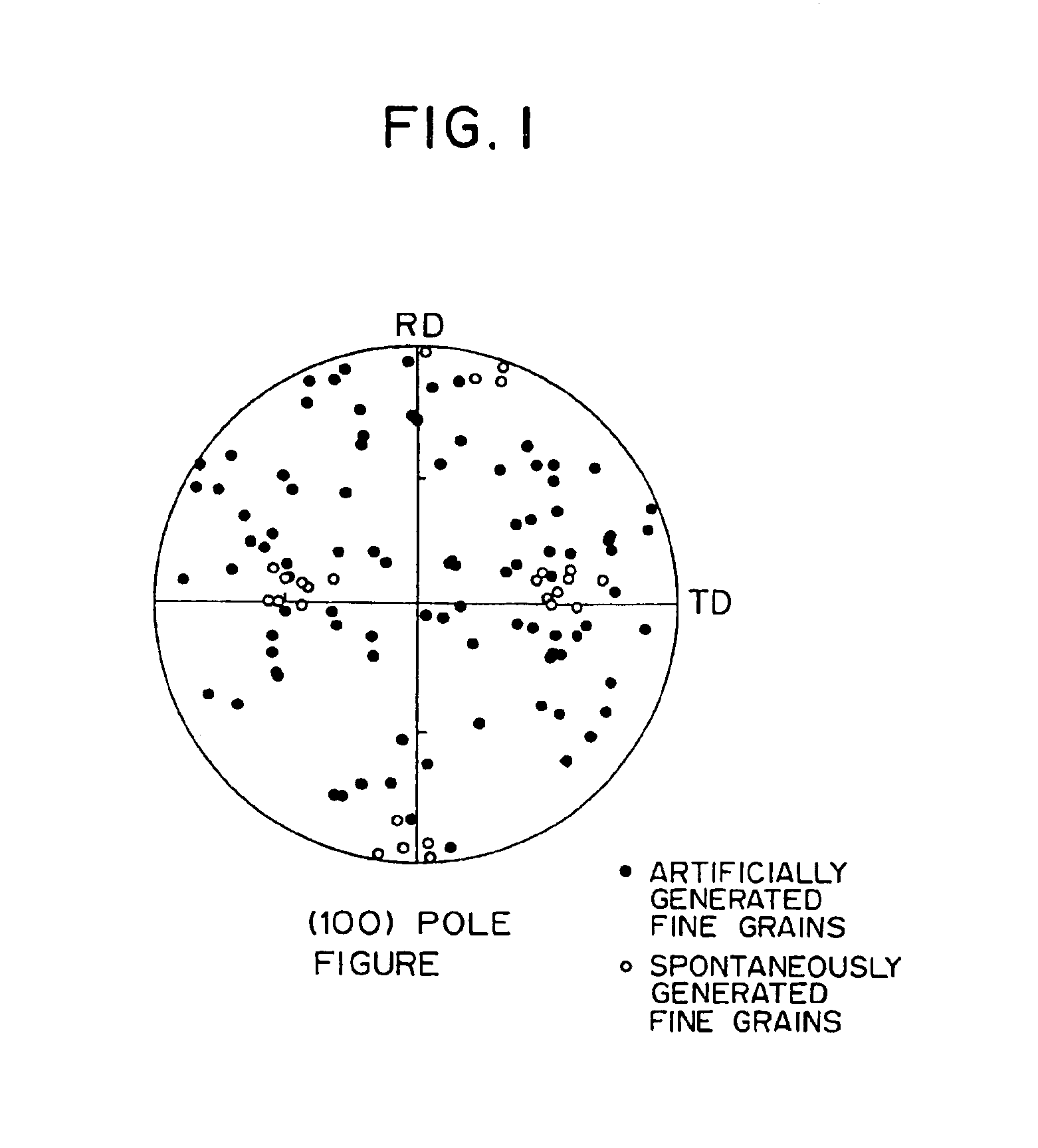Grain-oriented electromagnetic steel sheet
- Summary
- Abstract
- Description
- Claims
- Application Information
AI Technical Summary
Benefits of technology
Problems solved by technology
Method used
Image
Examples
example 1
[0235]After heating a steel slab comprising 0.08 wt % of C, 3.35 wt % of Si, 0.07 wt % of Mn, 0.02 wt % of Al, 0.05 wt % of Sb and 0.008 wt % of N with a balance of Fe and inevitable impurities at 1410° C., the slab was processed into a hot band steel sheet having a thickness of 2.2 mm by a conventional method. The hot band was then cold rolled to a thickness of 1.5 mm after a hot band annealing at 1000° C. for 30 seconds followed by pickling. After applying an intermediate treatment at 1080° C. for 50 second, the thickness of the sheet was finally adjusted to 0.22 mm by a warm rolling at a temperature of the steel sheet of 220° C. After a degreasing treatment and decarburization annealing at 850° C. for 2 minutes, the steel sheet was divided into two pieces. One piece was coated with an annealing separator containing MgO as a main component (Comparative Example). With respect to the other piece, a momentary electric discharge treatment at a voltage of 1 kV was applied to the areas ...
example 2
[0244]After heating a steel slab comprising 0.08 wt % of C, 3.35 wt % of Si, 0.07 wt % of Mn, 0.02 wt % of Al, 0.005 wt % of Bi and 0.008 wt % of N with a balance of Fe and inevitable impurities at 1400° C., the slab was processed into a hot band having a thickness of 2.6 mm by a conventional method. The hot band was then warm rolled to a final thickness of 0.34 mm with a steel sheet temperature of 250° C. after a hot band annealing at 1100° C. for 30 seconds followed by pickling. After a degreasing and decarburization annealing at 850° C. for 2 minutes, the steel sheet was divided into two pieces. One piece was coated with a annealing separator containing MgO as a main component without any additional treatment (Comparative Example). Sn was adhered to the areas having a diameter of 0.1 to 2.0 mm on the surface of the steel sheet of the other piece to suppress the growth of the secondary recrystallization grains. Adhering of Sn was carried out by scattering fused droplets of Sn on t...
example 3
[0252]After heating the steel slab having a composition shown in Table 6 at 1430° C., a hot band having a thickness of 2.6 mm was produced by a conventional method. After hot band annealing at 1000° C. for 30 seconds followed by pickling, an intermediate treatment was applied at 1050° C. for 50 seconds. The steel sheet was finally processed to a thickness of 0.26 mm by warm rolling at 230° C. After a degreasing treatment, grooves having a width of 50 μm and a depth of 25 μm were linearly provided with a tilt angle of 15° from the transverse direction of the coil and a repeating pitch of 4 mm along the longitudinal direction of the coil, and decarburization annealing was applied to the coil at 850° C. for 2 minutes.
[0253]The steel sheet was divided into two pieces and on one was coated with an annealing separator containing MgO as a main component without any additional treatment (Comparative Example).
[0254]Inhibition force promoting areas were formed by adhering Fe2O3 powder to the ...
PUM
| Property | Measurement | Unit |
|---|---|---|
| Temperature | aaaaa | aaaaa |
| Length | aaaaa | aaaaa |
| Length | aaaaa | aaaaa |
Abstract
Description
Claims
Application Information
 Login to View More
Login to View More - R&D
- Intellectual Property
- Life Sciences
- Materials
- Tech Scout
- Unparalleled Data Quality
- Higher Quality Content
- 60% Fewer Hallucinations
Browse by: Latest US Patents, China's latest patents, Technical Efficacy Thesaurus, Application Domain, Technology Topic, Popular Technical Reports.
© 2025 PatSnap. All rights reserved.Legal|Privacy policy|Modern Slavery Act Transparency Statement|Sitemap|About US| Contact US: help@patsnap.com



